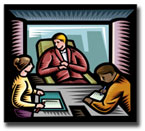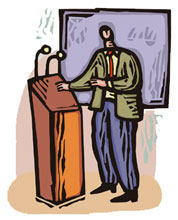Make Your Slide Presentations Remarkable
Using a Needs Assessment
by Adele Sommers
Around the world today, the stakes haven't ever been higher for undertaking many worthy endeavors. We're all looking for better ways to inform our audiences and inspire them to act!
Whenever we plan to give a presentation either in front of a live audience or online, we might decide to create a slide show to amplify our message, using Microsoft® PowerPoint®, Apple® Keynote, or Google® Presentations software.
Yet as much as we struggle to finesse our slide presentations, they don't necessarily produce the desired effects. Our audiences may not "get" our important points, or they might not do what we intend as a result.
What we need is a workable and repeatable formula for creating outstanding presentations that can capture attention, impart our ideas, and spark the audience actions we seek. This article, Part 3 in a series (see Part 1 and Part 2), covers the first stage of creating remarkable presentations -- the needs assessment.
Your Needs Assessment Should Answer Several Key Questions
To plan appropriately, you'll want to consider the purpose of your presentation, your audience, the outcome, the venue, and any downstream uses for your material. The answers can help determine how much time and effort to invest in the near term.
1. What's the purpose, what's at stake, and how critical is the outcome?
 For example, is the purpose of the presentation to: For example, is the purpose of the presentation to:
- Give a routine status update?
- Pitch a proposal or a project?
- Persuade people to donate to your cause?
- Present a study or research paper?
- Recommend a method or solution?
Routine status updates may not seem nearly as critical as courting a product sale, proposal acceptance, or project funding, for example. The need to make a strong, lasting impression increases with the importance of the occasion.
So what kind of "return on impression" (ROI) do you need to make?
2. What is your anticipated audience's frame of reference?
Truly understanding your audience's perspective will help you pinpoint the tone and degree of formality of your presentation. To do this, you can start by identifying a few fictional representatives of your expected audience, called personas.
Personas reflect the characteristics of typical colleagues, customers, clients, or constituents to whom you will be giving a presentation.
 You might want to select
a handful of these characters to research and profile in depth.
Think deeply about what they would need to hear -- and how they would need to hear it -- to become receptive to your ideas. You might want to select
a handful of these characters to research and profile in depth.
Think deeply about what they would need to hear -- and how they would need to hear it -- to become receptive to your ideas.
Especially if the audience will be new to your ideas or terminology, you'll want to consider how to bridge the gap between their frame of reference and yours. For example...
Demographically, will your audience be:
- From any particular generation?
- Specialists within a specific industry, field, or discipline?
- Coming from an entrepreneurial, academic, military, government, or corporate background?
- Executives, directors, managers, colleagues, or instructors in your own organization or institution?
- Political leaders or local government decision-makers?
- Members of a particular society or community?
- College students?
Psychographically, do they harbor certain beliefs, values, political views, buying patterns, and so on, that could help or hinder their ability to accept your ideas?
3. What actions do you want your audience to take as a result?
 After they hear your presentation, do you want people to: After they hear your presentation, do you want people to:
- Accept your proposal?
- Buy your products or services?
- Follow your recommendations?
- Approve funding for your projects?
- Give you a good academic grade?
- Endorse you or your organization?
- Contribute to your cause?
- Take some other action?
Be very specific about what you want and your "call to action." If you don't have an explicit or implicit request of your audience, why not?
Don't be wishy-washy about this; if you're unclear, your audience will be, too!
4. Where are you planning to deliver the presentation -- in person or online?
There are some very important differences between these two methods. In-person delivery gives people exposure to your personal energy and can be quite powerful. Online delivery, however, has become very cost-effective and convenient for many; there is no travel involved, no need to reserve a physical venue, and so forth.
So, be aware that depending on where you'll be delivering your presentation, you'll want to optimize it for the type of venue you'll be using.
For example, if you'll be presenting in person, you'll at least want to accommodate the split-attention factor related to viewing a foreground speaker and background slides (see Part 2 for details).
5. In the future, could your presentation expand into something more?
 For example, might you later expand or adapt your material to: For example, might you later expand or adapt your material to:
- Create a self-paced tutorial?
- Develop a classroom training program?
- Deliver the presentation via a Web seminar?
- Design a product package by adding reports, media, or other components?
- Produce a marketing or educational video? (You can do this by using the versatile TechSmith® Camtasia Studio® software, which plugs into PowerPoint and makes Flash movies from your presentations.)
Use Your Answers to Determine Your Time and Energy Investment
Next, consider from a practical standpoint how much effort your project requires. A low-key, routine status update is different from a high-stakes, persuasion-oriented presentation. Here's a general, high-level planning guide:
- If you have relatively little time, or the stakes are fairly low, and you have no plans to expand or redeploy your presentation in the future, you can make a strong impression and still produce it fairly quickly using the text, graphics, and special effects recommendations in Part 2.
- If you have more time, and the stakes are fairly high, or you think you might later develop the presentation into other products or uses, strongly consider applying all of the recommendations in Part 2 to provide the best foundation.
Another idea to consider is, "Do I really need a slide presentation?" There are some situations that might be better served without one, rather than one that looks hastily put together and fails to follow any of the principles. If you're short on time and can't find images, there are other options. One alternative is to put all of the details in handouts, and place only a one-sentence conclusion or key point in the middle of each slide.
In conclusion,
we can easily succumb to the temptation to whip something together in a hurry because we perceive that our time is limited, and perhaps it truly is. But using a needs assessment can help us plan presentations in a much more practical way, and thereby decide exactly how much time and effort to invest.
Copyright 2009 Adele Sommers
|


